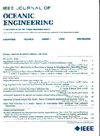水下物联网的水下反向散射网络:实际海洋通道的链路预算分析
IF 5.3
2区 工程技术
Q1 ENGINEERING, CIVIL
引用次数: 0
摘要
水下后向散射是一种新兴的超低功耗通信和网络技术。传统的水声调制解调器通过产生自身的声信号进行通信,而水下反向散射节点通过反射外部声信号进行通信,使其工作功率比现有的低功率调制解调器低5-6个数量级。然而,在实际采用该技术之前,仍有必要了解其在实际海洋通道中的链路预算。在本文中,我们对实际信道中的水下后向散射链路预算进行了全面的研究,考虑了后向散射通信系统特有的各种信号源和噪声源。我们开发了一种封闭形式的水下后向散射端到端链路预算模型,并在现实环境中进行了实验验证。我们首次通过实验验证了信噪比(SNR)作为距离和源电平函数的端到端分析模型。该模型不仅使我们能够在实验测量值的中位数0.75 dB内预测预期信噪比,而且还确定了提高水下后向散射性能的新方法,并在最先进的过去工作中扩大了其范围。然后,我们使用该验证模型模拟实际海洋通道下的后向散射性能,并了解系统和环境参数对端到端性能的影响。通过开发和验证链接预算模型,本文为水下后向散射在海洋气候变化监测、科学研究和沿海恢复力中的实际应用铺平了道路。本文章由计算机程序翻译,如有差异,请以英文原文为准。
Underwater Backscatter Networking for Subsea IoT: A Link-Budget Analysis in Practical Ocean Channels
Underwater backscatter is an emerging technology for ultra-low-power communication and networking. Unlike traditional underwater acoustical modems, which communicate by generating their own acoustical signals, underwater backscatter nodes communicate by reflecting external acoustical signals, enabling them to operate at 5–6 orders of magnitude less power than existing low-power modems. Yet, before the practical adoption of this technology, it remains necessary to understand its link budget in practical ocean channels. In this article, we perform a comprehensive investigation of the underwater backscatter link budget in practical channels considering various sources of signal and noise that are unique to backscatter communication systems. We develop a closed-form end-to-end link-budget model of underwater backscatter and perform experimental validations in real-world environments. For the first time, we experimentally verify the end-to-end analytical model of the signal-to-noise ratio (SNR) as a function of distance and source level. Not only does this model enable us to predict the expected SNR within a median of 0.75 dB of the experimentally measured one, but also to identify new methods that improve the performance of underwater backscatter and extend its range over state-of-the-art past work. We then use this validated model to simulate backscatter performance under practical ocean channels and understand the impact of system and environmental parameters on the end-to-end performance. By developing and validating the link budget model, this article paves the way for the practical adoption of underwater backscatter in applications of ocean climate change monitoring, scientific studies, and coastal resilience.
求助全文
通过发布文献求助,成功后即可免费获取论文全文。
去求助
来源期刊

IEEE Journal of Oceanic Engineering
工程技术-工程:大洋
CiteScore
9.60
自引率
12.20%
发文量
86
审稿时长
12 months
期刊介绍:
The IEEE Journal of Oceanic Engineering (ISSN 0364-9059) is the online-only quarterly publication of the IEEE Oceanic Engineering Society (IEEE OES). The scope of the Journal is the field of interest of the IEEE OES, which encompasses all aspects of science, engineering, and technology that address research, development, and operations pertaining to all bodies of water. This includes the creation of new capabilities and technologies from concept design through prototypes, testing, and operational systems to sense, explore, understand, develop, use, and responsibly manage natural resources.
 求助内容:
求助内容: 应助结果提醒方式:
应助结果提醒方式:


